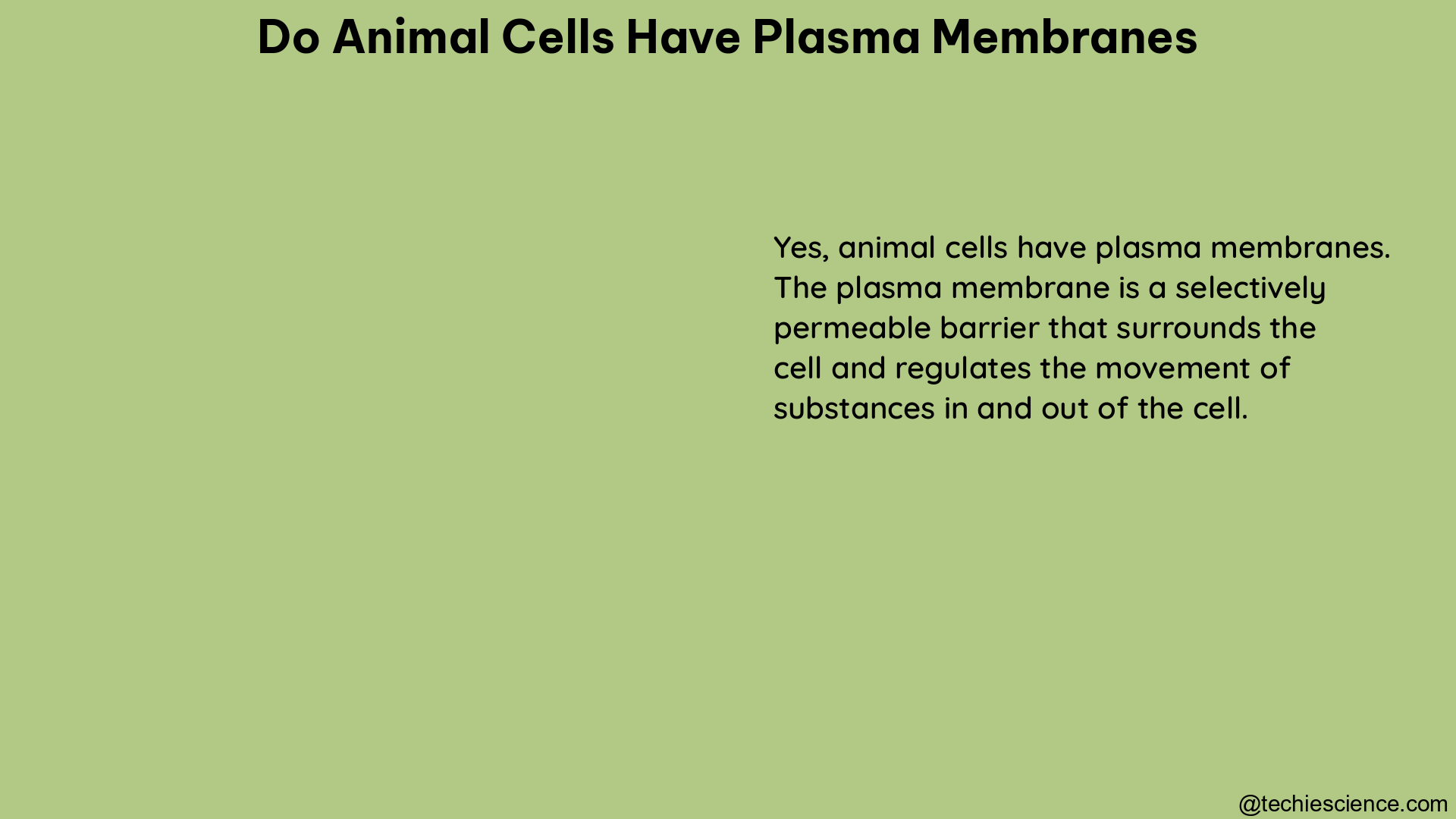Animal cells are the fundamental units of life in multicellular organisms, and they possess a variety of essential organelles and structures that enable their survival, growth, and function. One of the most critical components of animal cells is the plasma membrane, which serves as a selective barrier between the cell and its external environment.
The Plasma Membrane: Structure and Composition
The plasma membrane of animal cells is a thin, flexible, and selectively permeable barrier that surrounds the cell. It is composed of a phospholipid bilayer, with the hydrophilic (water-loving) heads of the phospholipids facing outward and the hydrophobic (water-fearing) tails facing inward. This arrangement creates a hydrophobic barrier that prevents the passage of water-soluble molecules.
Embedded within the phospholipid bilayer are a variety of proteins, including:
- Transmembrane proteins: These proteins span the entire thickness of the membrane and facilitate the transport of molecules across the membrane.
- Peripheral proteins: These proteins are attached to the surface of the membrane and perform various functions, such as cell signaling and cell-cell recognition.
- Glycoproteins: These proteins have carbohydrate groups attached to them and play a role in cell-cell adhesion and recognition.
The composition and arrangement of these membrane components can vary significantly between different cell types and even within the same cell, depending on the specific functions and requirements of the cell.
Functions of the Plasma Membrane

The plasma membrane of animal cells serves several critical functions, including:
-
Selective Permeability: The plasma membrane is selectively permeable, allowing certain molecules to pass through while blocking others. This is achieved through the use of specialized transport proteins, such as ion channels and carrier proteins, which facilitate the movement of molecules across the membrane.
-
Cell Signaling and Communication: The plasma membrane contains receptors that can bind to extracellular signals, such as hormones or neurotransmitters, and trigger intracellular responses. This allows the cell to respond to changes in its environment and coordinate its activities with other cells.
-
Structural Support: The plasma membrane, along with the cytoskeleton, provides structural support and shape to the cell, helping to maintain its integrity and organization.
-
Compartmentalization: The plasma membrane separates the cell’s contents from the external environment, creating distinct compartments within the cell that allow for specialized functions and the efficient organization of cellular processes.
-
Cell-Cell Interactions: The plasma membrane is involved in various cell-cell interactions, such as cell-cell adhesion, cell-cell recognition, and cell-cell communication, which are essential for the coordination and integration of multicellular organisms.
Specialized Membrane Structures
In addition to the basic phospholipid bilayer and associated proteins, animal cells can also possess specialized membrane structures, such as:
- Microvilli: These are finger-like projections of the plasma membrane that increase the surface area of the cell, facilitating the absorption of nutrients and other molecules.
- Cilia and Flagella: These are hair-like or whip-like projections of the plasma membrane that are involved in cell motility and the movement of extracellular fluids.
- Tight Junctions: These are specialized cell-cell adhesion complexes that form a seal between adjacent cells, preventing the passage of molecules between them and maintaining the integrity of epithelial tissues.
- Desmosomes: These are cell-cell adhesion complexes that connect the plasma membranes of adjacent cells, providing mechanical strength and stability to tissues.
Membrane Dynamics and Remodeling
The plasma membrane of animal cells is a highly dynamic structure that is constantly undergoing remodeling and reorganization in response to changes in the cell’s environment or internal signaling pathways. This includes processes such as:
- Endocytosis: The invagination of the plasma membrane to form vesicles that can transport materials into the cell.
- Exocytosis: The fusion of vesicles with the plasma membrane to release their contents outside the cell.
- Membrane Trafficking: The movement of vesicles and other membrane-bound organelles within the cell, facilitating the transport of materials and the recycling of membrane components.
- Membrane Fluidity: The ability of the plasma membrane to change its fluidity in response to changes in temperature, lipid composition, or the presence of certain molecules, which can affect its permeability and function.
Plasma Membrane and Disease
Defects or alterations in the structure and function of the plasma membrane can contribute to the development of various diseases and disorders, including:
- Cancer: Mutations in genes that regulate the expression or function of plasma membrane proteins can lead to uncontrolled cell growth and the development of cancer.
- Neurodegenerative Disorders: Disruptions in the plasma membrane of neurons can impair their ability to transmit signals and contribute to the development of neurodegenerative diseases, such as Alzheimer’s and Parkinson’s.
- Genetic Disorders: Inherited mutations in genes that encode plasma membrane proteins can lead to genetic disorders, such as cystic fibrosis and sickle cell anemia.
- Infectious Diseases: Many pathogens, such as viruses and bacteria, target the plasma membrane of host cells as a means of gaining entry and initiating infection.
In conclusion, the plasma membrane is an essential component of animal cells, serving as a selective barrier, a signaling platform, and a structural support. Its dynamic nature and specialized structures are critical for the survival, function, and integration of animal cells within multicellular organisms. Understanding the structure and function of the plasma membrane is crucial for advancing our knowledge of cellular biology and developing effective treatments for a wide range of diseases and disorders.
References:
- Alberts, B., Johnson, A., Lewis, J., Raff, M., Roberts, K., & Walter, P. (2002). Molecular Biology of the Cell (4th ed.). Garland Science.
- Lodish, H., Berk, A., Zipursky, S. L., Matsudaira, P., Baltimore, D., & Darnell, J. (2000). Molecular Cell Biology (4th ed.). W. H. Freeman.
- Purves, W. K., Sadava, D. E., Orians, G. H., & Heller, H. C. (2004). Life: The Science of Biology (7th ed.). Sinauer Associates.
- Voet, D., & Voet, J. G. (2011). Biochemistry (4th ed.). Wiley.
- Organelles In Animal Cells Essay | PDF – SlideShare. (n.d.). Retrieved from https://www.slideshare.net/slideshow/organelles-in-animal-cells-essay/264387013
- No animal cell has a ______. a. plasma membrane b. flagellum c. lysosome d. cell wall. (n.d.). Retrieved from https://homework.study.com/explanation/no-animal-cell-has-a-a-plasma-membrane-b-flagellum-c-lysosome-d-cell-wall.html
- Cell Membranes | Learn Science at Scitable – Nature. (n.d.). Retrieved from https://www.nature.com/scitable/topicpage/cell-membranes-14052567/
- Chapter 7 Homework Flashcards | Quizlet. (n.d.). Retrieved from https://quizlet.com/576112301/chapter-7-homework-flash-cards/

Hello, I am Piyali Das, pursuing my Post Graduation in Zoology from Calcutta University. I am very passionate on Academic Article writing. My aim is to explain complex things in simple way through my writings for the readers.